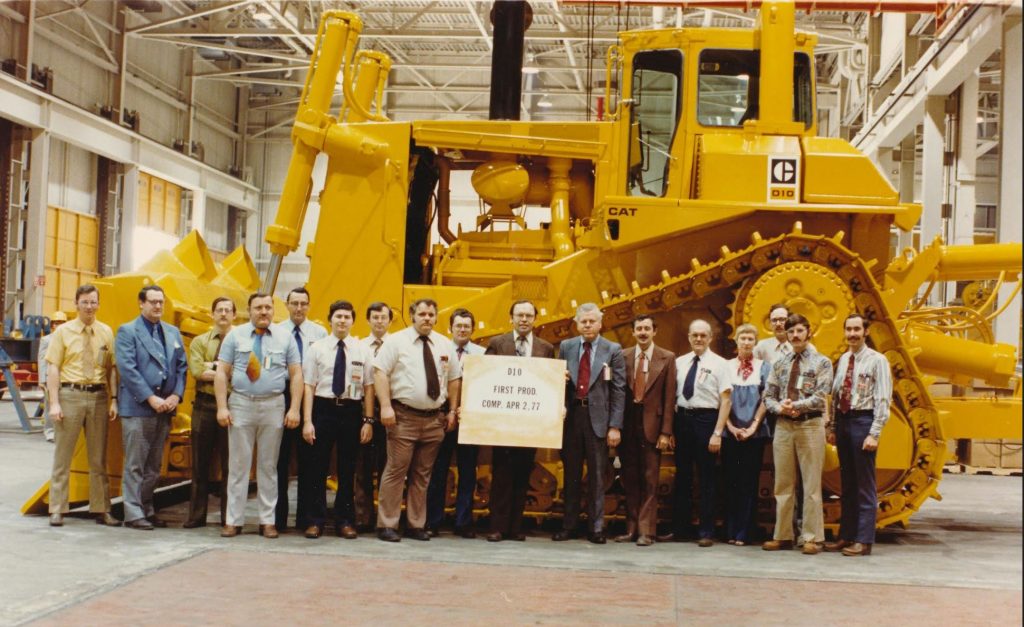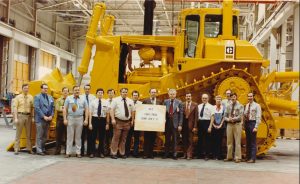DOZER: Cat’s innovative D10 celebrates 40 years
Forty years ago, this writer drove the first Cat D10 dozer delivered to Canada. The brute was the centrepiece of a well-attended […]

The first Cat D10 production model in 1977.

 The first Cat D10 production model in 1977.[/caption]
PEORIA, Ill. – Forty years ago this September, Caterpillar rolled off of its production lines 10 pilot models of the world’s largest, most powerful dozer, destined to leave a lasting legacy on the industry. The Cat D10 dozer’s radically different design, high weight and horsepower, and resilient undercarriage answered the growing calls from large mining and big heavy construction operations for a more powerful dozer.
The result of Cat’s patented elevated sprocket design was a machine with no rival for weight, power or productivity. Offering 50% higher productivity than Caterpillar’s largest dozer of that era, the D9 dozer, the D10 weighed over 86,180 kg and measured 4.6 metres tall, 3.7 metres wide and slightly more than 9.4 metres long. Power was supplied by the 522 kW D348, V12 diesel engine.
A changing industry in the late 1960s and early 1970s stretched the D9 to its productivity limits, and the mining industry led the charge for a dozer with more and more horsepower. Contractors working in predominantly hard rock applications also demanded a design that improved track longevity and durability.
The D10 research team established a set of design goals for the new dozer: high productivity; modular design; simplified maintenance; operator efficiency; and transportability. It quickly became evident that a new track design and improved undercarriage were needed to meet the production and durability goals for the new dozer.
Two years of testing led to the first elevated sprocket patent application and ultimately building the first two D10 test models in August of 1973. By separating the drive sprockets from the track roller frame and elevating them above the tracks, more track remained on the ground for improved traction. The elevated sprocket design was also better able to absorb ground shocks for longer life and greater operator comfort.
Beyond looking different, the new undercarriage design required the transmission to be mounted behind the engine to provide for the only track-type tractor final drive system with a common centerline between the steering clutches and brakes. It also allowed engineers to move both the dozer blade and ripper closer to the tractor, providing a concentrated center of gravity and improving the balance of the machine.
The pilot D10 dozers built in 1977 were immediately embraced by Caterpillar customers. Their ripping and pushing capabilities made a significant impact on the mining industry, as studies showed the cost per metre to move material using the D10 was comparable to that of larger draglines. The resilient undercarriage with elevated sprocket conformed to the ground better than solid tracks, helping to improve machine pushing power and undercarriage life and enhancing operator comfort.
The dozer’s modular concept helped to increase machine transportability, as removable components facilitated machine moves from location to location. Its modular design also substantially advanced assembly and service task efficiency.
The original big and bad Cat D10 legacy lives on today with thousands of Caterpillar elevated sprocket dozers operating around the world. The elevated sprocket track concept has been expanded to today’s Cat D6N and D6T medium dozers and the D8T, D9T and D11T large dozer models as well as the current D10T2 model.
Caterpillar will be happy to answers reader enquiries at www.Cat.com/requestCatinfo.
The first Cat D10 production model in 1977.[/caption]
PEORIA, Ill. – Forty years ago this September, Caterpillar rolled off of its production lines 10 pilot models of the world’s largest, most powerful dozer, destined to leave a lasting legacy on the industry. The Cat D10 dozer’s radically different design, high weight and horsepower, and resilient undercarriage answered the growing calls from large mining and big heavy construction operations for a more powerful dozer.
The result of Cat’s patented elevated sprocket design was a machine with no rival for weight, power or productivity. Offering 50% higher productivity than Caterpillar’s largest dozer of that era, the D9 dozer, the D10 weighed over 86,180 kg and measured 4.6 metres tall, 3.7 metres wide and slightly more than 9.4 metres long. Power was supplied by the 522 kW D348, V12 diesel engine.
A changing industry in the late 1960s and early 1970s stretched the D9 to its productivity limits, and the mining industry led the charge for a dozer with more and more horsepower. Contractors working in predominantly hard rock applications also demanded a design that improved track longevity and durability.
The D10 research team established a set of design goals for the new dozer: high productivity; modular design; simplified maintenance; operator efficiency; and transportability. It quickly became evident that a new track design and improved undercarriage were needed to meet the production and durability goals for the new dozer.
Two years of testing led to the first elevated sprocket patent application and ultimately building the first two D10 test models in August of 1973. By separating the drive sprockets from the track roller frame and elevating them above the tracks, more track remained on the ground for improved traction. The elevated sprocket design was also better able to absorb ground shocks for longer life and greater operator comfort.
Beyond looking different, the new undercarriage design required the transmission to be mounted behind the engine to provide for the only track-type tractor final drive system with a common centerline between the steering clutches and brakes. It also allowed engineers to move both the dozer blade and ripper closer to the tractor, providing a concentrated center of gravity and improving the balance of the machine.
The pilot D10 dozers built in 1977 were immediately embraced by Caterpillar customers. Their ripping and pushing capabilities made a significant impact on the mining industry, as studies showed the cost per metre to move material using the D10 was comparable to that of larger draglines. The resilient undercarriage with elevated sprocket conformed to the ground better than solid tracks, helping to improve machine pushing power and undercarriage life and enhancing operator comfort.
The dozer’s modular concept helped to increase machine transportability, as removable components facilitated machine moves from location to location. Its modular design also substantially advanced assembly and service task efficiency.
The original big and bad Cat D10 legacy lives on today with thousands of Caterpillar elevated sprocket dozers operating around the world. The elevated sprocket track concept has been expanded to today’s Cat D6N and D6T medium dozers and the D8T, D9T and D11T large dozer models as well as the current D10T2 model.
Caterpillar will be happy to answers reader enquiries at www.Cat.com/requestCatinfo.
Comments